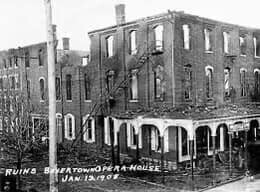Image


Friday, Jan. 13 was the 115th anniversary of The Rhoads Opera House Fire, a local tragedy that changed fire safety laws throughout America.
The Boyertown Historical Society will be hosting their annual memorial wreath laying at the grave of the unidentified in Fairview Cemetery, today, Sunday at 1pm. All are welcome to attend.
[Shared by the Boyertown Historical Society via Facebook, here is an excerpt from the book, One Day at a Time: A social history of Boyertown, Pennsylvania, written by Margaret Leidy Harner.]
"January 13, 1908: It was a night never to be forgotten in Boyertown. One of the deadliest fires in American history happened that cold, clear night of the full moon. It made international news; there were articles in London newspapers and the President of France sent a cablegram with condolences to the families of the victims. A catalyst for bringing about major changes, its impact was sobering, immediate and far reaching, from more stringent fire safety laws to descendants still living today.
There was an extravaganza playing that night in the second floor theater of the Rhoads building on the corner of East Philadelphia Ave and South Washington Street, known as the Opera House, sponsored by the Sunday School of St. John’s Lutheran Church. The play was called “The Scottish Reformation." It was a sell-out; almost 400 people were crammed into the theater. The play began at 8PM and the audience was enthusiastic.

After the third act, around 9:30, there was a “magic lantern” slide presentation. The projector emitted a harmless, hissing noise that startled the audience, and the commotion reached the cast behind the combustible curtain. One of the actors pulled it aside to see what was happening, upset a kerosene footlight, which ignited the linen curtain and started a fire that created a wall of flame between the audience and the stage. It soon escalated into a roaring inferno that enveloped the entire auditorium.
As the fire spread, the screaming, confusion, intense heat and suffocating smoke caused panic to grip the audience, and many rushed the double entrance doors that opened inward. A mass of frightened people pushed against those doors, wedging them shut, and the pressure of the frantic crowd prevented anyone from prying them open. They were trapped.
The fire escapes were unmarked and more than 3’ off the floor, very difficult for anyone, especially women in their long flowing dresses and heavy winter outerwear to maneuver. Fifteen minutes later, everyone remaining in the room was dead. Miraculously, more than 200 people escaped, but 170 died.

Firefighting efforts were useless. Firemen pulling the Keystone hose cart down Philadelphia Ave. from South Reading Ave. had not taken into account that the street had just been paved and the heavy engine would travel much faster on the smooth surface than they were used to on the dirt road. It bowled out of control, veered toward fireman John Graver, and crushed him against a tree, only one block from the fire.
The cart was destroyed and Graver was carried to Dr. Thomas Jefferson Boyer Rhoads’ surgery, where the doctor valiantly tried to save his life. Unfortunately, Graver died two hours later. John’s sister, Lottie Graver, also died that night as a result of burns and other injuries suffered in the fire.
It was Dr. Rhoads’ building that was on fire, but he and his wife had been spending a quiet evening at home until the fire began. By the time Friendship Hook and Ladder Company brought their horse drawn wagon to the scene, the building was fully engulfed in flames.
A frantic throng of sobbing relatives and friends gathered on the streets, wild with grief, waiting for news. No one slept in Boyertown that night.” In total, 170 people died that night.
Local businesses and the Washington School was turned into a makeshift morgue. It was reported that 55 volunteer undertakers came to Boyertown to help prepare the bodies, working non -stop. 25 of the 170 were never identified. The unidentified were placed in separate graves divided by 9” brick walls and is now marked with one large grave stone, listing their names."

To learn more on the fire, books are available for purchase from the Boyertown Historical Society. Choices include Midwinter Mourning & A Town In Tragedy by Mary J. Schneider, former long-time editor of the Boyertown Times.
Or check out the documentary here, https://www.youtube.com/watch?v=iSCGwWb9zfE